LEMON POPULAR VARIETIES, FERTILIZER, WEED CONTROL
LEMON POPULAR VARIETIES, FERTILIZER, WEED CONTROL
Citrus is an important fruit crop. Lemon is one of the important category of citrus. It is mainly known for its pulp and juice throughout the world. Different citrus fruits are used throughout the world as food or juice. In central India, Nagpur santra is grown on a large scale. Mandarin Production states are Assam, Dibrugarh and Brahmaputra valley. In India Citrus cultivation is done on an area of about 923 thousand hectare with annual production of 8608 thousand metric tons. In Punjab citrus is grown on 39.20 hectares of land.
SOIL
-
Clear the area: Remove any weeds, rocks, or other debris from the area where you plan to plant your lemon tree.
-
Test the soil: Have your soil tested to determine its pH level and nutrient content. Lemon trees prefer a slightly acidic soil with a pH of around 6.0 to 7.0.
-
Amend the soil: If necessary, add organic matter such as compost, well-rotted manure, or peat moss to improve soil texture and fertility.
-
Dig the planting hole: Dig a hole that is twice as wide and just as deep as the root ball of your lemon tree.
-
Plant the tree: Place the tree in the hole, making sure that the top of the root ball is level with the soil surface. Fill in the hole with soil, tamp it down gently, and water thoroughly.
-
Mulch: Apply a layer of mulch around the base of the tree to help retain moisture and suppress weeds.
-
Water regularly: Keep the soil moist but not waterlogged, especially during the first year of growth.
POPULAR VARIETIES WITH THEIR YIELD
The Punjab Baramasi is a type of lemon that shoots dropping fruit. The lemon has yellow fruits with a round shape and a tapering base. The lemon's seeds are absent, and its fruit is juicy. The average fruit yield from a Punjab Baramasi lemon tree is 84 kg.
Eureka is a type of tree that is semi-vigorous. It has a lemon-yellow skin color and a strong acidic juice. The fruit of this tree ripens in August.
Punjab apples are vigorous trees with light green foliage. They have medium-sized oval-shaped fruit that are filled with acidic juice. The fruits will mature in the months of November-December, and the average fruit yield is 80-100 kg per tree.
July is the earliest time to harvest fruit, since it contains few seeds. This yields an average of 84 kg per tree. In November, the fruit is seedless and yields an average of 80 kg per tree. Some other states have different harvest times, so it's important to know what variety of fruit you're buying.
Lisbon lemons are resistant to frost and high wind speeds, which means they produce fruit that are of medium size, with a lemon yellow color and a smooth surface.
Seedless Lucknow: Medium sized yellow fruit.
Pant lemons are a dwarf variety of lemon that are resistant to several common citrus diseases. They are also medium-sized and have juicy fruit.
There are different kinds of lemons, such as the Assam lemon, the Italian lemon, the Eureka lemon, and the Malta lemon.
SOWING
Time of sowing
The best season for planting is July-August.
Intercropping: Intercropping with cowpeas, vegetables, french beans can be done in initial two to three years.
Spacing
Spacing between plants should be kept between 4.5×4.5. Pits of size 60×60×60cm should be dug for planting seedlings. 10Kg of Farmyard Manure and 500g of single superphosphate should be applied to pits while planting.
Sowing Depth
Pits of size 60×60×60cm should be dug for planting seedlings.
Method of sowing
Propagation
Plants are propagated by budding or air layering.
WEED CONTROL
Weed can be controlled by hand-hoeing and also controlled by chemically, use glyphosate@1.6litre per 150 litre of water. Use glyphosate only on weeds not on crop plants.
IRRIGATION
Lemon requires irrigation at regular intervals. Lifesaving irrigation should be given in winters and summers. Irrigation is necessary for Flowering, Fruiting and proper plant growth. Over irrigation may also leads to diseases like Root rot and collar rot. High frequency irrigation is beneficial. Salty water is injurious for crop plants. Partial drying out of soil in spring may not affect plants.
IRRIGATION
Lemon requires irrigation at regular intervals. Lifesaving irrigation should be given in winters and summers. Irrigation is necessary for Flowering, Fruiting and proper plant growth. Over irrigation may also leads to diseases like Root rot and collar rot. High frequency irrigation is beneficial. Salty water is injurious for crop plants. Partial drying out of soil in spring may not affect plants.
PLANT PROTECTION
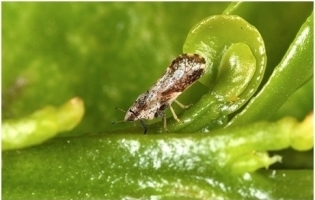
Insect-Pest and Their Management
Citrus Psylla: These are juice sucking pests. Damage is mainly caused by nymphs. It injects a plant toxin liquid which burns foliage and skin of fruit. Leaves curl and fall off prematurely. It can be controlled by pruning of diseased plants, burning them. Spraying of Monocrotophos-0.025% or carbaryl- 0.1% can also be helpful.
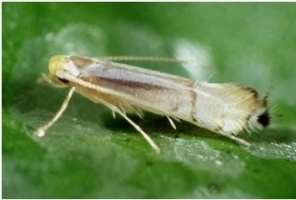
Leaf miner: Larvae inside the upper or lower surface of young and newly emerged leaves are curled and look distorted. Young trees show a reduction in growth due to leaf miner. Best management for leaf miner is to leave it alone and let the natural enemies to feed upon them and parasitize their larvae. It can also be controlled by spraying Phosphomidon @1ml or Monocrotophos @1.5ml per 3-4 times fortnightly. Pheromone traps are also available for detecting leaf miner moths.
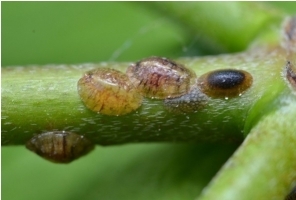
Scale Insects: Citrus scale insects are small insects that suck sap from the citrus trees and fruits. Honeydew is produced which is feasted upon by ants. They do not have much mouth parts. Male citrus scale has a short life span. There are mainly two types of scale on citrus plants armored scale and soft scales. Armored scale insects insert their mouth parts in the plant and never move again, eating and reproducing in the same spot. Soft scale bugs on citrus form a protective coating, which in turns cover citrus leaves and prevents photosynthesis. Once dead, soft scale will fall from tree instead of remaining stuck. They can be controlled with the introduction of indigenous parasitic wasps. Neem oil is also effective against them. Spraying of Parathion (0.03%) emulsion, dimethoate 150ml or malathion @0.1% are effective against scale control.
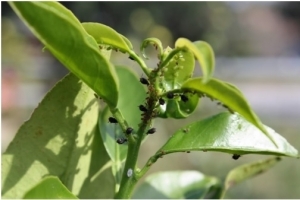
Aphids & Mealy Bugs: They are small sap sucking pests. Bugs are present on the underside of leaves. Synthetic pyritheriods or pest oil can be used to control aphids and bugs.
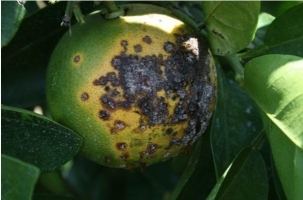
Disease and Their Management
Citrus Canker: Plants have lesions on stems, leaves and fruits with brown, water-soaked margins. Citrus canker bacteria can enter through plant’s stomata into the leaves. Younger leaves are highly susceptible. Lesions oozes bacterial cells which can be dispersed by blowing wind to healthy plants in area.
Contaminated equipment tends to spread disease to healthy plants. Bacteria can stay viable in old lesions for several months. It can be detected by appearance of lesions. It can be controlled by cutting of effected branches, twigs. Spraying of Bordeaux mixture @1%. Aqueous solution of 550ppm, Streptomycin Sulphate is also helpful in controlling citrus canker.
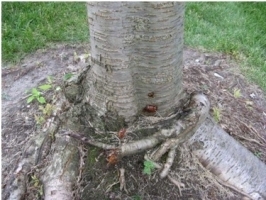
Gummosis: Exudation of gum from bark of tree is the characteristic symptom of gummosis disease. Affected plant leaves turns to pale yellow in color. Hardness masses of gum are common on stem and leaf surfaces. In severe cases, bark may be destroyed by rotting and tree may dies. Plant dies before the fruit matures. This disease is also called foot rot. This disease can be managed through proper selection of site with proper drainage, use of resistant varieties etc. Plant injuries should be avoided. Drench the soil with 0.2% metalaxyl MZ-72 + 0.5% trichodermaviride, which helps to control this disease. Bordeaux mixture should be applied to plant upto 50-75 cm height from ground level at least once in a year.
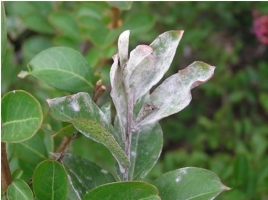
Powdery mildew: White cottony powdery growth is noticed on all aerial plant parts. Leaves tend to become pale yellow and crinkle. Distorted margins are also seen. Upper surface of leaves are more affected. Young fruits drop off prematurely. Yield is reduced significantly. To control powdery mildew, affected plant parts should be removed and destroyed completely. Carbendazim, three times at 20-22 days of interval helps to control this disease.
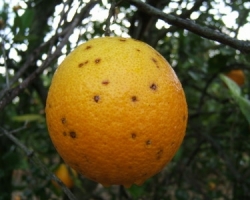
Black Spot: Black spot is a fungal disease. Circular, dark spots on fruits are seen. Copper spray in early spring should be sprayed on foliage helps to cure plants from black spots. It should be repeated in 6 weeks again.
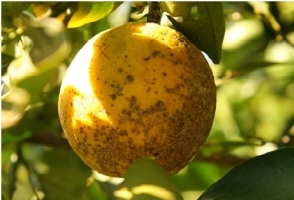
Lemon Scab: It affects some of the mandarin varieties and lemon fruits. Raised grey corky scabs on tree branches, fruits and leaves are seen causing distortions of the fruit. Fruits fall of at very early stages of growth. It is caused due to fungus. Copper spray mixed with white oil should be sprayed on the foliage to prevent lemon scab. 2 Table spoons of white oil to two liter of water should be added into 5 litre or copper spray mixture.
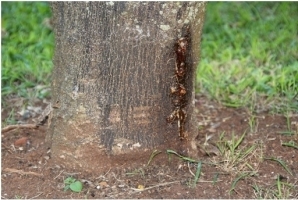
Collar Rot: Collar rot is also caused due to fungus. This disease mainly affects the bark on tree trunk. Bark begins to rot and forms a band just above ground surface, this band decay gradually and covers the whole trunk. It is very severe in some cases that even the trees may die. This is caused due to incorrect mulching, injury due to weeding, mowing etc. Tree may lose its vigor. To protect trees from collar rot, cut and scrape away the soft, infected bark to clean the trunk of tree. Mixture of copper spray or Bordeaux mixture should be painted on the affected part of the tree. Remove all the weak, diseased and congested tree branches to ensure proper air circulation.
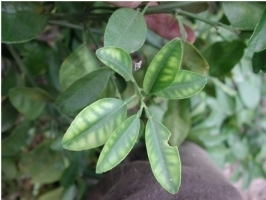
Zinc Deficiency: It is very common in citrus trees. It is notified as yellow areas between main lateral veins and midrib of the leaves. Twigs may die back, dense shoots having stunted bushy appearance is commonly seen. Fruits tend to become pale, elongated and small in size. Proper fertilizer application should be given to the citrus tree to prevent zinc deficiency. Zinc sulphate should be provided by dissolving 2 table spoons in 10 litres of water. This should be sprayed thoroughly on all the tree branches and foliage. It can also be cured by providing cow or sheep manure.
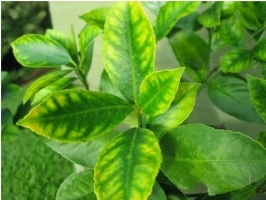
Iron deficiency: Color of new leaves changes to yellowish green. Iron chelates should be provided to the plants. Cow or Sheep manure is also helpful to cure plants from iron deficiency. This deficiency mostly occurs in case of alkaline soils.
HARVESTING
On attaining proper size, shape along with attractive color having TSS to Acid ratio of 12:1, kinnow fruits is ready for harvest. Depending upon variety fruits are generally ready for harvesting in Mid- January to Mid- February. Do harvesting at proper time as too early or too late harvesting will give poor quality.
POST-HARVEST
After harvesting, wash fruits with clean water then dip fruits in Chlorinated water@2.5ml per Liter water and then partially dried them. To improve appearance along with to maintain good quality, do Citrashine wax coating along with foam. Then these fruits are dried under shade and then packing is done. Fruits are packed in boxes
Posted
2 years ago
No comments yet! Why don't you be the first?





















Add a comment